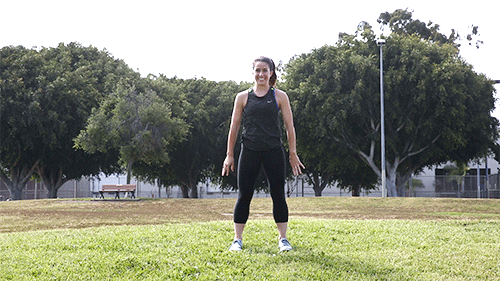How Do I Get the Most Out of a ‘One-Minute Workout’?
Last Update: March 11, 2020
I just read that a really tough one-minute workout is just as good as a 45-minute moderate workout. It seems too good to be true! If it is true, how does it work, and how can I do it on my own? —Melanie P.
Yep, it’s legit. High-intensity training has been a favorite of fitness pros for a while because you can get it done in half the time it takes to do a traditional workout, but get the same (or better) results. And while there were a few studies here and there that proved either the health or the fitness benefits—but never really both—of a high-intensity training session, this new study from McMaster University proves that repeated, super-short bouts of strenuous exercise (with active recovery between each bout) has benefits equivalent to 45 minutes of medium-difficult exercise.
But, let’s be real, it’s not just 60 seconds flat. The study actually examined 20 seconds of hard work followed by a two minutes of low-intensity exercise, repeated three times and finished up with a three minute cool down. Combined, that’s 60 seconds of high-intensity work, six minutes of low-intensity work, and a three-minute stretch—that all adds up to 10 minutes. (The study also recommended a quick, two-minute warmup.)
Even if it’s not exactly a “one-minute” workout, you have to admit 10 to 12 minutes total sounds a whole lot better than a 45-minute spin class or run on the treadmill, right? Here’s a full version of a high-intensity workout you can try on your own. The great thing is that you can do it pretty much anywhere. All you need is a little space and a timer, and you’re good to go!
Remember, during *these 20-second moves, go as fast and as hard as you can—you should feel breathless and tired. Then take the two-minute recovery (we’ll be doing slow mountain climbers in this workout) nice and slow to let your heart rate drop a little bit. Try not to stop completely even if you need to catch your breath. Just slow it down a little or hold a plank pose.
Warm-up: 2 minutes (optional)
A nice, easy jog or walk will do the trick—just get moving enough to shake out your body and get it ready to move.
*Tuck jumps: 20 seconds
Ready? Here it goes! The first high-intensity move is the quad-burning tuck jump. Start by squatting low, and then jumping as high as you can and bringing your knees up toward your chest. Repeat, without stopping, for 20 seconds.
Slow mountain climbers: 2 minutes
Start in a plank position, with your hands directly beneath your shoulders and abs in. From here, move one knee forward to your chest, drawing your belly button up and in and flexing your core muscles. Come back to your plank, and then repeat on the other side. Repeat for two minutes.
*Burpees: 20 seconds
Ah, the classic! We’re pumping up the burpee by adding a tuck jump at the end to really raise your heart rate. Start standing. Drop your hands down to the ground, jump your feet backwards to a plank position, then jump feet forward so your toes are right behind your wrists. Stand up, and then tuck jump. That’s the whole thing! Repeat as quickly as you can for 20 seconds.
Slow mountain climbers: 2 minutes
Recover. Move slowly here—researchers found that allowing the heart rate to come down between high-intensity sets, also known as sprints, is necessary for getting the maximum benefits.
*High knees: 20 seconds
Last hard round! Bring your arms to your sides, and bend your elbows at a 90-degree angle with palms facing down. Your forearms should be parallel to the ground. From here, start to run in place. Your goal is to make sure your knees come up far enough to hit your palms every time. Go as fast as you can for 20 seconds.
Slow mountain climbers: 2 minutes
Finally, you’re almost done! Let your heart rate slow down here, and pay special attention to pulling in your abs to protect your lower back as you get more and more tired.
Cool down: 3 minutes
If you have time, do a little stretching and breathing to cool down. This could include a light yoga flow, or just taking an easy walk until you feel like you’ve caught your breath and can talk normally.
And that’s it—you’ve done your workout for the day. Pretty simple on paper, challenging in real life, and definitely do-able.
One thing to note: High-intensity interval training seems to work best just three days a week. Any more than that, and the body doesn’t have time to recover; and less than that is not challenging enough. Try it out and let us know what you think in the comments below!
Photo credit: Alicia Cho



